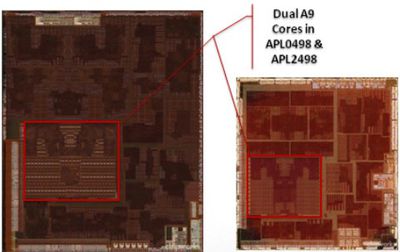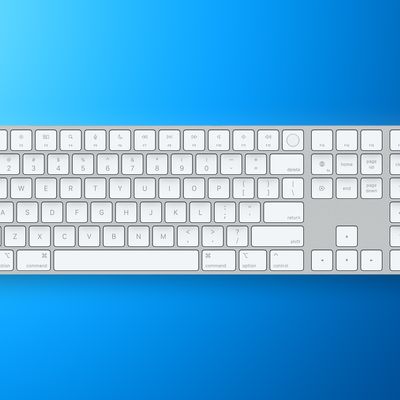Apple TV's A5 Chip Includes Surprise Die Shrink to 32nm [Updated: Same Chip Found in iPad 2]
While the new 1080p-capable Apple TV has been available for nearly a month, Chipworks has now gotten around to tearing down the device's custom A5 system-on-a-chip, discovering with some surprise that the chip is actually a new design from Apple using a die shrink from the 45-nm process used in the A5 of the iPhone 4S to a new 32-nm process. The teardown also reveals what many had suspected: that the "single-core" A5 advertised by Apple for the new Apple TV is actually a standard dual-core chip with one of its cores disabled.
The new A5 processor die is not a single core processor, but contains a dual core processor. Either Apple is only utilizing one core or they are binning parts. Parts binning is a common process in semiconductors where devices are segregated (binned) based on meeting a subset of the overall requirements, in this case they could disable the “bad” core, this increases the usable die per wafer, lowering the cost.
As for the die shrink on the Apple TV's A5, the development raises question about why Apple made the investment in such changes to the A5 for a relatively low volume device like the Apple TV. Despite the benefits of a die shrink, the cost of implementing it for the Apple TV alone would not be inconsequential.
 Dual ARM cores from iPhone 4S A5 chip (left) and Apple TV A5 chip (right)
Dual ARM cores from iPhone 4S A5 chip (left) and Apple TV A5 chip (right)The new A5 measures nearly 41% smaller than its predecessor, coming in at 69.6 mm². Process shrinking not only reduce costs by fitting more dies on a wafer, but it also improves performance and lowers power consumption. This is a very complex chip for a relatively low volume part (for Apple); one would think they have greater plans for this new A5 variant.
Even the A5X used in the new iPad is manufactured using 45-nm processes, making the Apple TV the company's first iOS device to move to the smaller and more efficient 32-nm process.
Update: Chipworks has now updated its report to note that the 32-nm A5 is also showing up in the latest models of the iPad 2. The observation makes it clear that Apple is using the lower-volume models as a testing ground for the more efficient 32-nm processes, with fully-functional dual-core chips landing in the iPad 2 while the Apple TV receives single-core chips with either one core intentionally disabled or one defective core.
(Thanks, @anexanhume!)
Popular Stories
Apple provided developers with the third beta of an upcoming iOS 26.2 update, and there are still new features that are being added with each beta that we get. We've rounded up all of the changes that Apple made in beta 3.
AirDrop
Apple added new AirDrop functionality, providing a way for two people to share files temporarily without having to add one another as contacts.
iOS 26.2...
Apple today announced an expansion of AppleCare+ coverage in India, with new options for monthly and annual plans, and the addition of Theft and Loss for iPhone for the first time.
Options for monthly and annual AppleCare+ plans in India provide more choice and flexibility, allowing users to keep coverage for as long as they require. Apple's vice president of Worldwide iPhone Product...
Apple's iPhone development roadmap runs several years into the future and the company is continually working with suppliers on several successive iPhone models at the same time, which is why we often get rumored features months ahead of launch. The iPhone 18 series is no different, and we already have a good idea of what to expect for the iPhone 18 Pro and iPhone 18 Pro Max.
One thing worth...
Apple's annual four-day Black Friday through Cyber Monday shopping event is returning on Friday, November 28 through Monday, December 1 in many countries, including the United States, Canada, Australia, New Zealand, France, Germany, Italy, Spain, the United Kingdom, Belgium, the Netherlands, Sweden, Thailand, and others.
During the shopping event, customers can get an Apple gift card with...
In select U.S. states, residents can add their driver's license or state ID to the Wallet app on the iPhone and Apple Watch, providing a convenient and contactless way to display proof of identity or age at select airports and businesses, and in select apps.
Starting this Wednesday, November 19, the feature will be available to residents of Illinois.
The announcement confirmed that the...
Apple's eighth-generation iPad mini is highly likely to arrive next year, offering a significant refresh of the device with at least four major new features.
OLED Display
The next-generation version of the iPad mini could feature an OLED display, as part of Apple's plan to expand the display technology across many more of its devices. Apple's first OLED device was the Apple Watch in 2015, ...
A new study has revealed that the iPhone 17, iPhone 17 Pro, iPhone 17 Pro Max, and iPhone Air achieve significantly faster average Wi-Fi speeds compared to the iPhone 16 series, thanks to Apple's custom-designed N1 chip.
The study was conducted by Ookla, the company behind the popular Speedtest website and app. It said the results are based on global, crowdsourced Speedtest user data...
We're getting closer to Black Friday, which lands next week on Friday, November 28. In the lead-up to the shopping holiday, we're tracking a few lowest-ever prices on Apple's most popular Macs, including the M4 MacBook Air and brand new M5 MacBook Pro.
Note: MacRumors is an affiliate partner with some of these vendors. When you click a link and make a purchase, we may receive a small payment,...
We're officially in the month of Black Friday, which will take place on Friday, November 28 in 2025. As always, this will be the best time of the year to shop for great deals, including popular Apple products like AirPods, iPad, Apple Watch, and more. In this article, the majority of the discounts will be found on Amazon.
Note: MacRumors is an affiliate partner with some of these vendors. When ...
Apple today released updated firmware for several accessories, including the 140W USB-C Power Adapter, the Magic Trackpad 2, the Magic Trackpad USB-C, the Magic Keyboard with Touch ID, and the Magic Keyboard with Touch ID and Numeric Keypad.
There is no word on what's included in the updated firmware at this time, but it could offer performance improvements and security updates. Accessory...


























